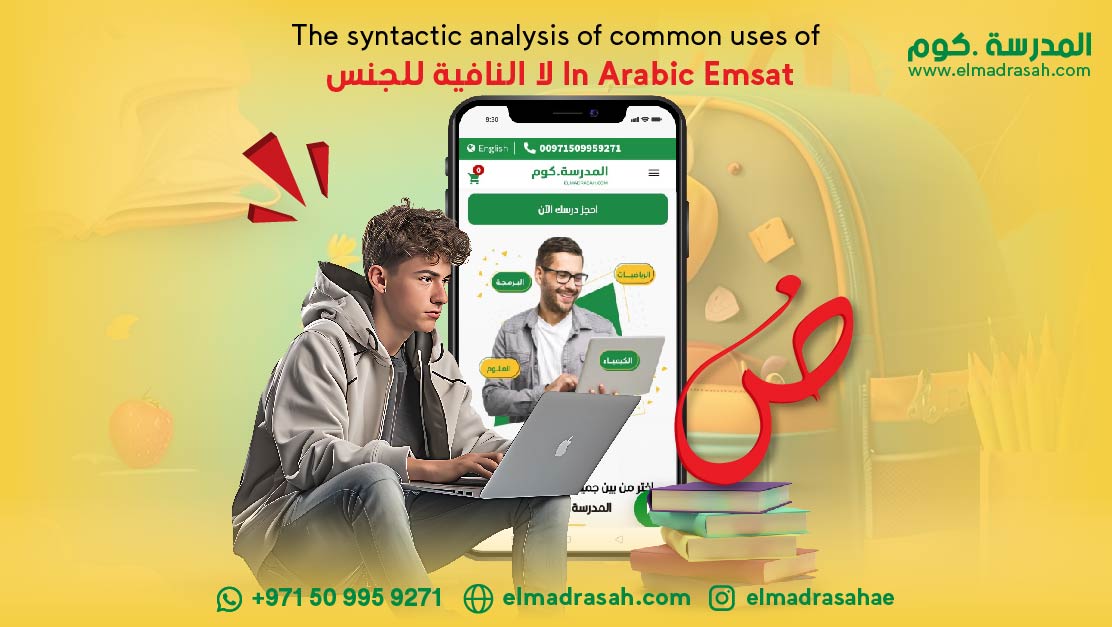
The Arabic language is considered one of the most difficult and branched languages among the world’s languages, as many learners of this language face difficulty in keeping up with its many branches and changing patterns, in addition to sounds, letters, grammatical inflections, and vocabulary.
This made it included in the list of the most difficult languages in the world to learn, and this is not only for learners who speak other languages but even for native speakers learners.
The Arabic language is one of the heritage languages with a long history, meaning that it has ancient historical value, and the EMSAT Arabic exam covers most of these. Branches.
Therefore, in this article, we will talk about the Emsat Arabic exam, the most important branches of the Arabic language, including grammar and the common uses of no negation of gender in arabic emsat
No negation of gender in arabic emsat
As mentioned in a previous article, the most important points that the Arabic Emsat exam focuses on, are summed up in measuring students’ ability to understand, analyze, and express using the Arabic language, but the branches of the Arabic language are multiple, including:
- Grammar: studies the rules and structures of sentences and phrases in the Arabic language. Grammar deals with the rules of morphological structure, parsing, and the correct arrangement of sentence elements.
- Morphology: It is concerned with the study of verb conjugation and word formation in the Arabic language, including changing letters, tense, number, gender, and more.
- Rhetoric: studies the methods of expression and rhetoric in the Arabic language, including different rhetorical methods, simile, metaphor, metaphor, metaphor, rhythm, and others.
- Literature: It deals with the study of Arabic literature and various literary works, including poetry, prose, theatre, novels, short stories, and literary criticism.
- Historical linguistics and culture: It is concerned with studying the development of the Arabic language through the ages and its historical changes, and includes branches such as Arabic dialects, the Qur’anic language, and others.
- Letter sounds: which is concerned with the sounds and phonetics of the Arabic language, including Arabic sounds, the phonetic system, and phonetic changes in the language.
All of these branches are divided in their lessons and structure. Does the Arabic Emsat exam focus on all of them? The answer here will be that the EMSAT Arabic exam often deals with all of these branches, but we can say that it focuses on the basics such as:
- Grammar and Morphology: Students are tested on their knowledge of the rules of grammar and morphology in the Arabic language, including sentence structures, parsing, verb conjugation, and sentence analysis.
- Rhetoric and Style: Students are tested on their ability to understand and analyze rhetorical techniques used in Arabic texts, including simile, metaphor, metaphor, rhythm, and others. Students’ ability to express themselves smoothly and appropriately and use appropriate linguistic methods is also evaluated.
- Reading and Comprehension: Students’ ability to read Arabic texts correctly and understand them correctly is tested, by answering text comprehension and analysis questions.
- Writing: Students’ writing skills in Arabic are assessed, including their ability to organize and formulate ideas clearly and logically, and to use grammatical and morphological rules correctly.
- Literature: The exam may include questions related to the study of literary works, poetry, prose, short stories, and novels and the understanding and analysis of literary texts.
One of the most difficult branches of these branches, of which no Arabic language test lacks, is the foundation of the language, is the branch of grammar and morphology, as the basis of which the language, and among its rules is لا النافية للجنس, which is added to the nominal sentence to negate it.
no negation of gender in arabic emsat, is a variety of letters used in the Arabic language that is used to negate a verb and carries different grammatical connotations depending on the context of its use. Here are some common uses of no negation of gender in arabic emsat and their grammatical analysis:
- no negation of gender in arabic emsat in absolute negation:
Hamza Al-Maqsura: It is used in the absolute negation of verbs that are in the imperfect past or the present tense. Example: He did not eat (he did not eat).
Present accusative verb: It is used to negate actions in the present accusative tense.
Example: He does not eat (he does not eat).
- no negation of gender in conditional negation:
Conditional sentence: It is used to negate the verb in the conditional sentence. Example: if he does not eat (if he does not eat).
The conditional accusative sentence: It is used to negate the verb in the conditional accusative sentence.
Example: As long as you don’t eat (as long as you don’t eat).
- no negation of gender in the interrogative negation:
Negative interrogative sentence: It is used to negate the verb in the negative interrogative sentence.
Example: Can you not eat? (Can you not eat?).
- no negation of gender in the negative conditional negation:
Negative conditional sentence: It is used to negate the verb in the negative conditional sentence. Example: If he does not eat, he will not grow (If he does not eat, he will not grow).
- no negation of gender in partial negation:
Negative partial sentence: It is used to negate part of the sentence.
Example: He eats vegetables, but does not eat meat (He eats vegetables, but does not eat meat).
- no negation of gender in the negative interrogative negation:
Negative interrogative sentence: It is used to negate the verb in the negative interrogative sentence.
Example: Didn’t you eat the food? (Didn’t you eat the food?)
The grammatical analysis of لا النافية للجنسmay differ depending on the linguistic tense, the type of sentence, and the general context. It should be noted that these uses are common, but they are not the only possible uses of لا النافية للجنس.
Preparing for the Arabic Emsat exam
لا النافية للجنس is considered one of the most widely used rules of grammar and morphology in our daily lives due to its multiple uses. Like other grammar rules, it must be prepared and practised for the Emsat exam. Questions on grammar and morphology may come in several forms, including
- Sentence Analysis: Students are asked to analyze the given sentence in terms of grammatical structures, syntax and conjugation.
- Completion: Students are asked to complete the given sentences correctly using appropriate verbs, nouns and correct grammatical structures.
- Definition: Students are asked to define some grammatical and morphological terms used in the Arabic language.
- Correction: Students are asked to correct grammatical or morphological errors in given sentences.
- Phonological analysis: Students are asked to analyze the sounds and letters in words in terms of diacritics, morphology, and modulation.
Among the frequently asked questions about لا النافية للجنس are:
- Complete the sentence using لا النافية للجنس correctly:
______ eats fruits.
The man drinks tea, ______ coffee.
- Turn the sentence into a negative using لا النافية للجنس:
Child playing in the garden.
The student understands the lesson.
- Give the sentence an opposite meaning by using لا النافية للجنس:
The boy goes to school.
Mother writes a letter.
- Analyze the given sentence and identify the function of لا النافية للجنس in it:
I don’t see the book.
- Correct the grammatical errors in the given sentence:
I am not satisfied with the result.
- Use no as a negative in a sentence depending on the context:
Come to the party, ______ is late.
These are some of the common questions about لا النافية للجنس. The questions for لا النافية للجنس may take many different forms, but they remain under the same idea, so do not worry if you find questions that are differently shaped.
At elmadrasah.com, we can train you on all types of questions in the Arabic Emsat exam and its branches, including grammar, morphology, certainly, and لا النافية للجنس, in the best possible way, though:
- A group of skilled teachers with experience and competence in teaching all subjects and tests, and we can prepare you in the optimal way.
- Helping you know the correct ways to prepare for the Arabic Emsat test and the basic skills that need to be polished to achieve the desired results.
- We care about the individual skills of each student, so our courses are individual online. Each student has a teacher who follows up with him permanently, and you can ask him about anything.
- Providing the necessary educational sources and resources for the student, so he does not need to spend much of your time on searching, etc.
- All this and more is provided to you at very affordable prices, so do not hesitate to contact us, make sure to ask about our packagesز















